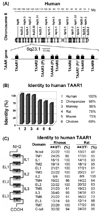Trace amine-associated receptor 1 as a monoaminergic modulator in brain
- PMID: 19482011
- PMCID: PMC2748138
- DOI: 10.1016/j.bcp.2009.05.031
Trace amine-associated receptor 1 as a monoaminergic modulator in brain
Abstract
Brain monoaminergic systems play critical roles in mood, cognition, emotion, reward, learning and attention, and aberrance in brain monoaminergic activity is associated with a variety of neuropsychiatric disorders/diseases. The present commentary focuses on trace amine-associated receptor 1 (TAAR1) and its potential regulatory roles in brain monoaminergic systems. TAAR1 was discovered in 2001 and has been established to be a G-protein-coupled receptor signaling through the cAMP pathway. This receptor is activated by a broad spectrum of agonists, although there are notable species differences in ligand efficacy and potency. TAAR1 is expressed and widely distributed in brain monoaminergic systems and co-localized with the dopamine transporter in a subset of dopaminergic neurons in rhesus monkey and mouse brain substantia nigra. TAAR1 activation by the common biogenic amines, the trace amine beta-phenylethylamine and methamphetamine alters the monoamine transporter function in both mouse and rhesus monkey brain synaptosomes, suggesting a modulatory role for this receptor in the presynaptic regulation of monoaminergic activity. However, little is known about other functional roles of TAAR1 in the brain. With a purpose to promote further studies on this receptor, we herein discuss the recent findings that provide insights into the functional significance and biological relevance of this receptor as a modulator in brain monoaminergic systems.
Figures




Similar articles
-
Rhesus monkey trace amine-associated receptor 1 signaling: enhancement by monoamine transporters and attenuation by the D2 autoreceptor in vitro.J Pharmacol Exp Ther. 2007 Apr;321(1):116-27. doi: 10.1124/jpet.106.116863. Epub 2007 Jan 18. J Pharmacol Exp Ther. 2007. PMID: 17234900
-
Modulation of monoamine transporters by common biogenic amines via trace amine-associated receptor 1 and monoamine autoreceptors in human embryonic kidney 293 cells and brain synaptosomes.J Pharmacol Exp Ther. 2008 May;325(2):629-40. doi: 10.1124/jpet.107.135079. Epub 2008 Feb 29. J Pharmacol Exp Ther. 2008. PMID: 18310473
-
Cloning, expression, and functional analysis of rhesus monkey trace amine-associated receptor 6: evidence for lack of monoaminergic association.J Neurosci Res. 2008 Nov 15;86(15):3435-46. doi: 10.1002/jnr.21783. J Neurosci Res. 2008. PMID: 18627029 Free PMC article.
-
TAAR1 as an emerging target for the treatment of psychiatric disorders.Pharmacol Ther. 2024 Jan;253:108580. doi: 10.1016/j.pharmthera.2023.108580. Epub 2023 Dec 22. Pharmacol Ther. 2024. PMID: 38142862 Free PMC article. Review.
-
Potential of Ligands for Trace Amine-Associated Receptor 1 (TAAR1) in the Management of Substance Use Disorders.CNS Drugs. 2021 Dec;35(12):1239-1248. doi: 10.1007/s40263-021-00871-4. Epub 2021 Nov 12. CNS Drugs. 2021. PMID: 34766253 Free PMC article. Review.
Cited by
-
Tako-tsubo cardiomyopathy: how to understand possible pathophysiological mechanism and the role of (123)I-MIBG imaging.J Nucl Cardiol. 2014 Aug;21(4):730-8. doi: 10.1007/s12350-014-9855-y. Epub 2014 Jan 25. J Nucl Cardiol. 2014. PMID: 24464623 Review.
-
Functional evolution of the trace amine associated receptors in mammals and the loss of TAAR1 in dogs.BMC Evol Biol. 2010 Feb 18;10:51. doi: 10.1186/1471-2148-10-51. BMC Evol Biol. 2010. PMID: 20167089 Free PMC article.
-
Effects of the trace amine-associated receptor 1 agonist RO5263397 on abuse-related effects of cocaine in rats.Neuropsychopharmacology. 2014 Sep;39(10):2309-16. doi: 10.1038/npp.2014.91. Epub 2014 Apr 18. Neuropsychopharmacology. 2014. PMID: 24743376 Free PMC article.
-
Role of TAAR1 within the Subregions of the Mesocorticolimbic Dopaminergic System in Cocaine-Seeking Behavior.J Neurosci. 2017 Jan 25;37(4):882-892. doi: 10.1523/JNEUROSCI.2006-16.2016. J Neurosci. 2017. PMID: 28123023 Free PMC article.
-
Regulation by Trace Amine-Associated Receptor 1 (TAAR1) of Dopaminergic-GABAergic Interaction in the Striatum: Effects of the Enhancer Drug (-)BPAP.Neurochem Res. 2025 Feb 4;50(2):94. doi: 10.1007/s11064-025-04337-7. Neurochem Res. 2025. PMID: 39903411 Free PMC article.
References
-
- Lindemann L, Ebeling M, Kratochwil NA, Bunzow JR, Grandy DK, Hoener MC. Trace amine-associated receptors form structurally and functionally distinct subfamilies of novel G protein-coupled receptors. Genomics. 2005;85:372–385. - PubMed
-
- Bunzow JR, Sonders MS, Arttamangkul S, Harrison LM, Zhang G, Quigley DI, et al. Amphetamine, 3,4-methylenedioxymethamphetamine, lysergic acid diethylamide, and metabolites of the catecholamine neurotransmitters are agonists of a rat trace amine receptor. Mol Pharmacol. 2001;60:1181–1188. - PubMed
-
- Miller GM, Verrico CD, Jassen A, Konar M, Yang H, Panas H, et al. Primate trace amine receptor 1 modulation by the dopamine transporter. J Pharmacol Exp Ther. 2005;313:983–994. - PubMed
-
- Gloriam DE, Bjarnadottir TK, Yan YL, Postlethwait JH, Schioth HB, Fredriksson R. The repertoire of trace amine G-protein-coupled receptors: large expansion in zebrafish. Mol Phylogenet Evol. 2005;35:470–482. - PubMed
Publication types
MeSH terms
Substances
Grants and funding
LinkOut - more resources
Full Text Sources
Other Literature Sources
Molecular Biology Databases

